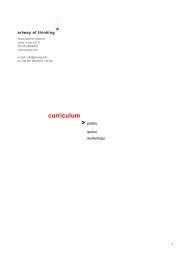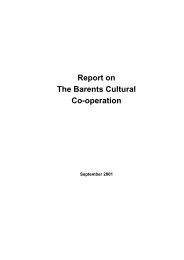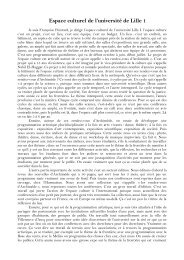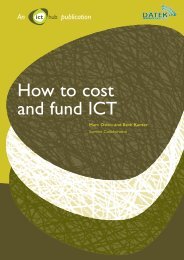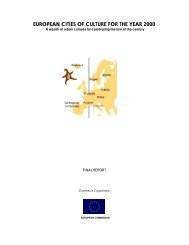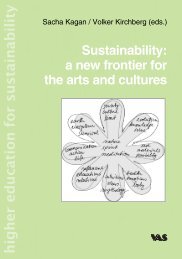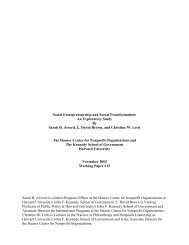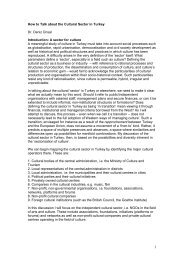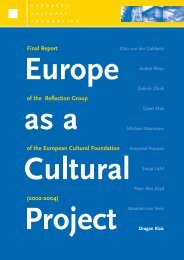A guide to the export and import of cultural goods between Russia ...
A guide to the export and import of cultural goods between Russia ...
A guide to the export and import of cultural goods between Russia ...
You also want an ePaper? Increase the reach of your titles
YUMPU automatically turns print PDFs into web optimized ePapers that Google loves.
Chapter 3: European Union Member States<br />
Hungary<br />
CHAPTER<br />
In <strong>the</strong> last five years, contemporary Hungarian culture has returned <strong>to</strong> <strong>the</strong> intellectual <strong>and</strong><br />
artistic stage in <strong>Russia</strong>. After <strong>the</strong> Heads <strong>of</strong> State <strong>of</strong> both countries reached <strong>the</strong> relevant<br />
agreement, <strong>Russia</strong>n – Hungarian <strong>cultural</strong> relations witnessed a great leap forward. It was<br />
agreed <strong>to</strong> establish new quality principles <strong>and</strong> forms <strong>of</strong> cooperation <strong>between</strong> <strong>the</strong> Ministries<br />
<strong>of</strong> Culture <strong>of</strong> Hungary <strong>and</strong> <strong>Russia</strong>, as fixed in pro<strong>to</strong>cols signed for 2005–2007, <strong>and</strong><br />
<strong>the</strong> process <strong>of</strong> planning for <strong>the</strong> next three years has already started.<br />
Cultural seasons in both countries from 2004–2006 opened genuinely new chapters in<br />
<strong>the</strong> field <strong>of</strong> artistic relations <strong>between</strong> Hungary <strong>and</strong> <strong>Russia</strong>. In a parallel way <strong>and</strong> almost<br />
at <strong>the</strong> same time, over 200 <strong>cultural</strong> events were organised, not only in both capitals, but<br />
also in regional centres. Nearly 800 artists, painters, musicians <strong>and</strong> scholars <strong>to</strong>ok part in<br />
those events. Exhibitions such as “The Hungarian Monarchy <strong>between</strong> two empires” <strong>and</strong><br />
“Budapest in <strong>the</strong> eyes <strong>of</strong> two generations: 1945–2005” in <strong>the</strong> State Museum <strong>of</strong> His<strong>to</strong>ry in<br />
Moscow, “100 years – 100 puppets” in both capitals, as well as <strong>the</strong> exhibition <strong>of</strong> selected<br />
Hungarian art <strong>of</strong> <strong>the</strong> early 20th century at <strong>the</strong> Hermitage became significant elements <strong>of</strong><br />
<strong>the</strong> introduction <strong>of</strong> Hungarian artistic traditions <strong>to</strong> <strong>the</strong> <strong>Russia</strong>n public.<br />
At <strong>the</strong> same time, shows <strong>of</strong> <strong>the</strong> most contemporary trends <strong>of</strong> different Hungarian artistic<br />
generations (including multimedia) led <strong>to</strong> <strong>the</strong> renewal <strong>of</strong> contacts <strong>between</strong> <strong>the</strong> educational<br />
institutions <strong>of</strong> both countries in <strong>the</strong> arts fields. The regular <strong>and</strong> varied presence <strong>of</strong><br />
Hungarian artistic culture in <strong>the</strong> exhibition halls <strong>and</strong> festivals <strong>of</strong> <strong>Russia</strong> is completed by<br />
<strong>the</strong> increasing number <strong>of</strong> books published: in <strong>the</strong> past three years nearly fifty books by<br />
Hungarian authors have been published in <strong>Russia</strong>n <strong>and</strong> distributed, not only in Moscow<br />
but also in larger regional libraries.<br />
The Embassy <strong>of</strong> Hungary in Moscow <strong>to</strong>ge<strong>the</strong>r with <strong>the</strong> Hungarian Cultural, Scientific <strong>and</strong> Informational<br />
Centre in Moscow are <strong>the</strong> key institutions for <strong>the</strong> organisation <strong>of</strong> <strong>cultural</strong> exchanges<br />
<strong>between</strong> both countries <strong>and</strong> <strong>the</strong>ir activity reaches outside Moscow, including those areas with a<br />
similar Finno-Ugrian population. In 2005 <strong>the</strong> construction <strong>of</strong> a network <strong>of</strong> “Hungarian cabinets”<br />
was begun in different <strong>Russia</strong>n cities. These have been created for teaching Hungarian language<br />
<strong>and</strong> culture. At present, <strong>the</strong> cabinets <strong>of</strong> Saint Petersburg <strong>and</strong> Khanty-Mansiisk are already functioning<br />
<strong>and</strong>, by <strong>the</strong> end <strong>of</strong> 2007, it is planned <strong>to</strong> open ano<strong>the</strong>r three such regional cabinets.<br />
WHAT LEGISLATION APPLIES TO THE IMPORT/EXPORT OF CULTURAL GOODS<br />
BETWEEN HUNGARY AND RUSSIA?<br />
NATIONAL<br />
Act No. 64 <strong>of</strong> 2001 on <strong>the</strong> Protection <strong>of</strong> Cultural Heritage<br />
Decree 17/2001 on Restrictions <strong>to</strong> <strong>the</strong> Export <strong>of</strong> Cultural Objects<br />
115



